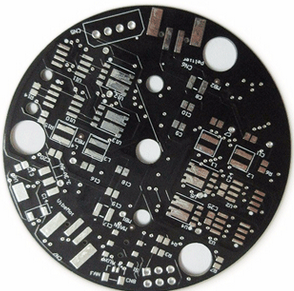1. Screen printing method:
Usually we call the circuit board "printed circuit board" (English abbreviation PCB), which comes from its "screen printing" process, and its basic process is:
Design layout - tracing - exposure board (making screen printing master) - printing - chemical corrosion - cleaning and surface treatment - printing soldering, marking, solder mask and other layers - cutting, punching and other mechanical processing - finished circuit board
This method has many production links and complex processes. It is mainly used in the mass production of PCB boards and is rarely used under laboratory conditions.
2. Engraving method
The engraving method is completed by a professional engraving machine, and the actual electrical connection is obtained after the excess copper foil on the copper plate is removed by the mechanical milling process. The accuracy is high, but the processing speed is very low and the cost is relatively high.

3. Freehand method
Use a pen or a pen-like tool to draw some anti-corrosion paint directly on the copper clad laminate, and then perform chemical corrosion and other steps. Today's electronic components are small in size, the pin spacing is smaller (on the order of millimeters), and the copper foil traces are also small, so it has become very difficult to draw by hand.
4. Layout method
There is a "standard pre-cut symbol and tape" available in the electronics store. You can select the corresponding symbol (mainly the pad) and tape according to the circuit design layout and paste it on the copper foil surface of the copper-clad plate. Use a softer hammer, such as smooth rubber, plastic, etc. to hit the sticker to make it fully adhere to the copper foil. Focus on the turning and overlapping of the line. When it is cold, you can use a heater to heat the surface to enhance the adhesion effect. After it is posted, it can be corroded.
5. Use pre-coated photosensitive copper clad laminate
A special copper clad laminate is used, and the surface of the copper foil is pre-coated with a layer of photosensitive adhesive material, so it is called "pre-coated photosensitive copper clad laminate", also called "photosensitive board". The production method is as follows:
Print the PCB diagram drawn on the computer as a black and white graphic at a ratio of 1:1. Take a photosensitive board equivalent to the size of the drawing, and tear off the protective film. Use a glass plate or a plastic transparent plate to press the drawing and the photosensitive PCB board tightly. After exposure for 1-5 minutes under an ultraviolet exposure machine, use the developer to mix with water at 1:20 for development. When the exposed part (unnecessary copper coating) is completely When exposed, it can be corroded with ferric chloride by washing it with water. After the operation is proficient, it is possible to make a trace with an accuracy of 0.1mm.
At present, the price of "pre-coated photosensitive copper clad sheet" on the market is still relatively high.
6. Thermal transfer method
The printed circuit board graphics made with a computer are printed on a special thermal transfer paper that has been specially processed by a laser printer. The "toner" of the laser printer is black plastic particles containing magnetic substances. Then cover the copper-clad board with transfer paper and send it to the plate-making mechanism.
The heat transfer machine mainly adopts the principle of heat transfer. Inside the machine, there is a set of 2 specially made high temperature resistant silicone cylindrical rollers to form a transmission mechanism. Using two infrared quartz heating tubes to evenly heat the two silica gel cylindrical rollers to 180.5 degree Celsius, at the same time, the silica gel cylindrical rollers are two pressure rollers. The maximum temperature resistance of its surface can reach 300 degree Celsius. These two groups of rubber rollers are driven through transmission. The system is driven by a synchronous motor, which rotates at a low speed and at a constant speed.
When the thermal transfer paper and the copper-clad board pass through the gap between the silica gel cylindrical rollers with higher temperature and greater pressure, the carbon powder adsorbed on the thermal transfer paper will melt. Since the thermal transfer paper is specially processed, its surface is covered with several layers of special material coatings through polymer technology, so that the thermal transfer paper has the characteristics of high temperature resistance and non-sticking. When the temperature reaches 180.5 degree Celsius, the adsorption force of the thermal transfer paper on the melted toner drops sharply. Under the action of pressure, the melted toner is completely adsorbed on the copper-clad board. After the copper-clad board cools, a tight print is formed. Graphics, complete the entire thermal transfer process.
When the graphics are transferred to the copper-clad board, that is to say, the toner of the printer forms a graphic protective layer on the copper-clad board. Because the laser printer toner is made of polymer materials containing resin, it has good corrosion resistance to the corrosive solution (FeCl3 solution), so after the FeCl3 solution is corroded, a beautifully crafted printed circuit board can be formed.